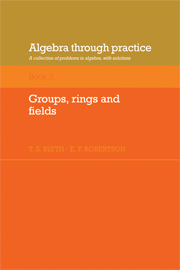2: Rings and fields
Published online by Cambridge University Press: 05 June 2012
Summary
In this section we shall deal with algebraic structures that have two laws of composition. A ring R is a non-empty set with two laws of composition, written as addition and multiplication, such that
(1) R is an abelian group under addition;
(2) the multiplication is associative;
(3) these laws are linked by the distributive laws
(∀x, y, z ∈ R) (x + y)z = xz + yz and z(x +y) = zx + zy.
When R has a multiplicative identity we often say that R is a ring with a 1, or a ring with an identity. When the multiplication is commutative we say that R is a commutative ring. The additive identity element 0 is called the zero of the ring. In a ring it is possible to have xy = 0 with x ≠ 0 and y ≠ 0. Such elements are called zero divisors. A commutative ring with a 1 which has no zero divisors is called an integral domain. If the ring R has a 1 and x ∈ R is such that there exists y ∈ R with xy = 1 = yx then we say that y is an (hence the) inverse of x in R. If every non-zero element of the commutative ring R with a 1 has an inverse then we say that R is a field. Thus, R is a field if
(a) R is an additive abelian group;
(b) R \ {0} is a multiplicative abelian group;
(c) the distributive laws hold.
- Type
- Chapter
- Information
- Algebra Through PracticeA Collection of Problems in Algebra with Solutions, pp. 19 - 31Publisher: Cambridge University PressPrint publication year: 1984



